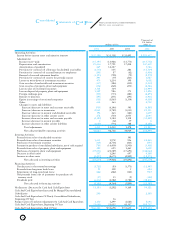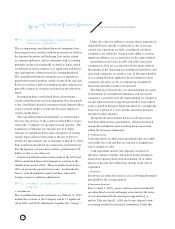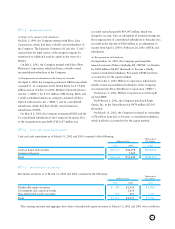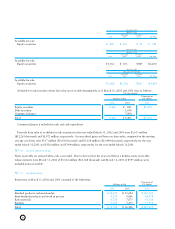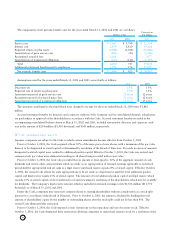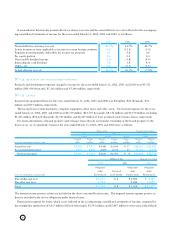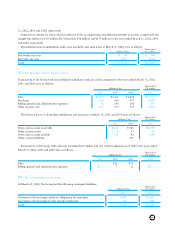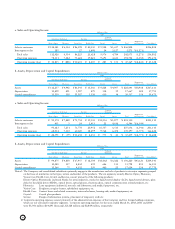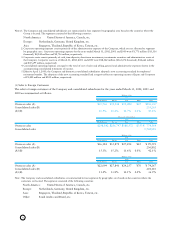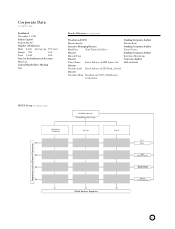Pentax 2002 Annual Report Download - page 45
Download and view the complete annual report
Please find page 45 of the 2002 Pentax annual report below. You can navigate through the pages in the report by either clicking on the pages listed below, or by using the keyword search tool below to find specific information within the annual report.
43
The components of net periodic benefit costs for the year ended March 31, 2002 and 2001 are as follows:
Thousands of
Millions of Yen U.S. Dollars
2002 2001 2002
Service cost ¥1,667 ¥1,798 $ 12,534
Interest cost 1,879 1,810 14,128
Expected return on plan assets (2,194) (2,568) (16,496)
Amortization of prior service cost (163) (83) (1,226)
Recognized actuarial loss 1,021 7,677
Amortization of transitional obligation (210) (210) (1,579)
Total 2,000 747 15,038
Additional retirement benefits paid to employees 1,996 176 15,007
Net periodic benefit costs ¥3,996 ¥923 $ 30,045
Assumptions used for the years ended March 31, 2002 and 2001 are set forth as follows:
2002 2001
Discount rate 2.5% 3.5%
Expected rate of return on plan assets 5.5% 5.5%
Amortization period of prior service cost 12 years 12 years
Recognition period of actuarial gain / loss 12 years 12 years
Amortization period of transitional obligation 15 years 15 years
The amounts contributed to the fund which were charged to income for the year ended March 31, 2000 were ¥1,882
million.
Accrued retirement benefits for directors and corporate auditors of the Company and its consolidated domestic subsidiaries
are paid subject to approval of the shareholders in accordance with the Code. Accrued retirement benefits recorded in the
accompanying consolidated balance sheets at March 31, 2002 and 2001, included amounts for directors and corporate audi-
tors in the amount of ¥254 million ($1,910 thousand) and ¥343 million, respectively.
No»10 shareholders' equity
Japanese companies are subject to the Code to which certain amendments became effective from October 1, 2001.
Prior to October 1, 2001, the Code required at least 50% of the issue price of new shares, with a minimum of the par value
thereof, to be designated as stated capital as determined by resolution of the Board of Directors. Proceeds in excess of amounts
designated as stated capital were credited to additional paid-in capital. Effective October 1, 2001, the Code was revised and
common stock par values were eliminated resulting in all shares being recorded with no par value.
Prior to October 1, 2001, the Code also provided that an amount at least equal to 10% of the aggregate amount of cash
dividends and certain other cash payments which are made as an appropriation of retained earnings applicable to each fiscal
period shall be appropriated and set aside as a legal reserve until such reserve equals 25% of stated capital. Effective October
1, 2001, the revised Code allows for such appropriations to be set aside as a legal reserve until the total additional paid-in
capital and legal reserve equals 25% of stated capital. The amount of total additional paid-in capital and legal reserve which
exceeds 25% of stated capital can be transferred to retained earnings by resolution of the shareholders, which may be available
for dividends. The Company’s legal reserve amount, which is included in retained earnings, totals ¥1,566 million ($11,774
thousand) as of March 31, 2002 and 2001.
Under the Code, companies may issue new common shares to existing shareholders without consideration as a stock split
pursuant to a resolution of the Board of Directors. Prior to October 1, 2001, the amount calculated by dividing the total
amount of shareholders’ equity by the number of outstanding shares after the stock split could not be less than ¥50. The
revised Code eliminated this restriction.
Prior to October 1, 2001, the Code imposed certain restrictions on the repurchase and use of treasury stock. Effective
October 1, 2001, the Code eliminated these restrictions allowing companies to repurchase treasury stock by a resolution of the




